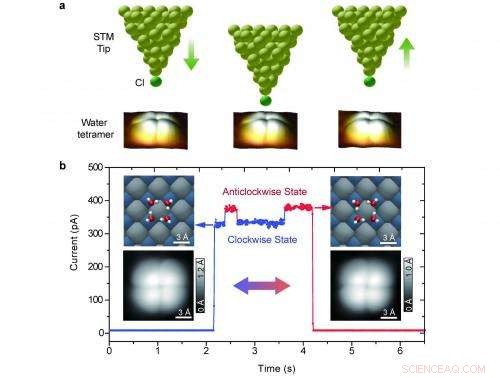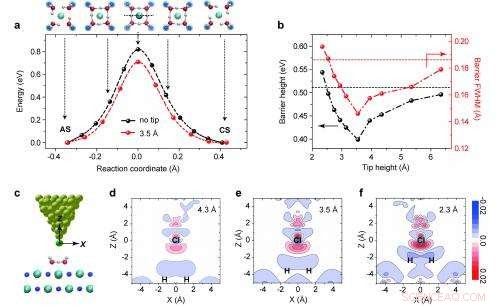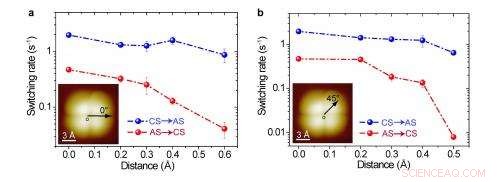
Chiralitetsväxling av en H2O-tetramer. en, Schematisk som visar manipulation av tetramerens kiralitet med en Cl-terminerad spets. Vänster:tetrameren förblir i medursläge (CS) när spetsen är långt borta från tetrameren (gap inställd med V =5 mV och I =5 pA). Mitten:att minska spetshöjden med 230 pm leder till chiralitetsbyte. Höger:lyfter spetsen tillbaka till den ursprungliga höjden lämnar tetrameren i motursläge (AS). b, Tunnelströmspår registrerat under chiralitetsmanipulationen som visas i a. Två strömnivåer kan tydligt urskiljas i området 300 - 400 pA, där de låga och höga strömnivåerna motsvarar CS och AS, respektive. Vänster och höger infällningar:Adsorptionskonfiguration (övre) och STM-bilder (nedre) av CS- och AS-tetramerer, respektive. Parametrar för STM-bilderna:V =20 mV och I =150 pA. De gröna stjärnorna i STM-bilderna anger spetspositionen där det aktuella spåret förvärvas. O, H, Au, Cl- och Na+ betecknas med rött, vit, gyllene, cyan och blå sfärer, respektive. Kredit:Courtesy Ying Jiang.
Det finns mer med kvanttunnling än vad man ser – eller snarare, visualiseringstekniken. (Kvanttunneling är ett kvantmekaniskt fenomen där en partikel övergår genom ett klassiskt förbjudet energitillstånd.) De flesta diskussioner om kvanttunnlar fokuserar på inkoherent enpartikeltunnling; å andra sidan, kvanttunnelering i samband med protondynamik involverar vanligtvis många vätebindningar samtidigt, som leder till vad som kallas korrelerad tunnling med många kroppar . (Mångkroppsproblemet hänvisar till egenskaperna hos mikroskopiska system som beskrivs av kvantmekaniken, som består av ett stort antal interagerande partiklar – dvs. ≥ 3 – som kan trassla in sig.) Nackdelen är att medan enpartikeltunnel är väl förstått, tunnelarbete med många kroppar är fortfarande höljt i mystik. Nyligen, dock, forskare vid Pekings universitet, Peking rapporterade observation i verkliga rymden av samordnad protontunnel i en cyklisk vattentetramer – ett makromolekylärt nanokluster som består av fyra vattenmolekyler arrangerade i en slinga eller ring – genom att använda ett kryogent skanningstunnelmikroskop (STM). Forskarna fann att närvaron av Cl - kloranjon (en negativt laddad klorjon) vid STM-spetsens spets kan antingen förstärka eller undertrycka den samordnade tunnlingsprocessen baserat på kopplingssymmetrin mellan jonen och protonerna, och tillägger att deras arbete kan möjliggöra kontroll av protonernas kvanttillstånd med precision i atomär skala.
Prof. Ying Jiang diskuterade uppsatsen att han, Prof. En-Ge Wang och deras kollegor publicerade i Naturfysik , noterade att en av de största utmaningarna de stötte på var att direkt visualisera den samordnade tunnlingen av fyra protoner i en individuell vätebunden vattentetramer adsorberad på en guldstödd halitfilm. "Ett grundläggande krav är att lokalisera i verkliga rymden positionen för protoner inom det vätebundna nätverket, så att protonernas rörelse kan spåras, " berättar Jiang Phys.org . "Detta är extremt svårt för alla mikroskop på grund av protonernas lätta massa och små storlek - och ännu värre är att protonernas färdsträcka över vätebindningarna är mindre än en ångström (10 -10 m). Som ett resultat, Att angripa detta problem kräver idealiskt förmågan att komma åt den inre frihetsgraden för vattenmolekylen. Lyckligtvis, vi utvecklade en ny submolekylär avbildningsteknik förra året 1 som tillåter oss att särskilja orienteringen av vattenmolekyler såväl som vätebindningsriktningen." Denna teknik är vad som banade väg för forskarna att ta itu med protondynamiken inom det vätebundna nätverket.
"Vidare, " Jiang fortsätter, "den samordnade tunnlingen eller många-kroppskorrelerade tunnlingen av protonerna är extremt känslig för miljön i atomär skala, och kan lätt störas eller till och med dödas av sonderna." Detta beror på det faktum att samordnad tunnling av protoner är en koherent kvantprocess, vilket kräver att alla protoner har exakt samma fas – och den asymmetriska kopplingen mellan sonderna och protonerna kan förstöra faskorrelationen mellan protonerna och släcka den kollektiva tunnlingen. "Med andra ord, man kan lätt förstöra en sådan samordnad tunnelprocess bara för att STM-spetsen inte är i rätt position. Därför, vi måste placera STM-spetsen mycket exakt inuti vattentetrameren för att säkerställa den symmetriska kopplingen, där de fyra protonerna alla är lika kopplade till STM-spetsen." Att söka efter en sådan exakt position kräver en hel del omsorg och tålamod:Om STM-spetsen är avstängd med endast 10 picometers (10 -12 m), forskarna kan få helt andra resultat.
Ett annat problem var att finna att närvaron av kloranjonen vid STM-spetsens spets kan antingen förstärka eller undertrycka den samordnade tunnlingsprocessen, beroende på detaljerna i kopplingssymmetrin mellan Cl-anjonen och protonerna. "Jag måste betona att det är mycket svårare att kontrollera den samordnade tunnlingen av protoner än att bara visualisera denna process - det betyder att man samtidigt måste manipulera flera kvantpartiklar i verkliga rymden." Det är, medan STM-spetsen inte bara fungerar som en lokal sond, men kan användas för att manipulera de enskilda atomerna eller molekylerna på ytan med precision i atomär skala, att manipulera många kroppstillstånd är utmanande. "Det är viktigt att alltid hålla kopplingsgeometrin mellan STM-spetsen och fyra protoner på ett symmetriskt sätt under manipulationen, " påpekar Jiang. "Annars, den samordnade tunnlingen är lätt undertryckt eller till och med släckt."
Dessutom, Jiang fortsätter, Cl anjonen vid spetsens spets är mycket viktig för att uppnå effektiv manipulation av den samordnade protontunnlingen. "För att vara ärlig, vi lärde oss faktiskt detta av en olycka:I månader, vi försökte kontrollera den samordnade tunnlingsprocessen med en bar metallspets, men alla försök misslyckades. En dag kraschade spetsen in i det guldstödda natriumkloridfilmsubstratet på grund av en felaktig funktion. Oväntat, använder detta "dåliga" tips, vi kunde förbättra tunneleringshastigheten mycket effektivt." Forskarna fastställde senare att detta inträffade eftersom spetsen plockade upp en kloratom från natriumkloridytan - och eftersom kloratomen är elektronegativ till sin natur, spetsen är negativt laddad. Den långväga elektriska interaktionen mellan den negativt laddade kloratomen och de positivt laddade protonerna leder sedan till undertryckandet av tunnelbarriären.
"Utan Cl - dricks, protonen måste resa en lång sträcka från en vattenmolekyl till den andra, och energibarriären är ganska hög. Att infoga en kloranjon mellan vattenmolekylerna skapar en "brygga" för protonerna. Attraktionen av Cl - hjälper protonerna, som det var, och hjälper därmed protonöverföringsprocessen, Jiang förklarar, "Det är den fysiska analogin till varför energibarriären undertrycks av spets/protonkopplingen."

Effekt av spetsen på reaktionsbarriären för protonöverföring. en, Reaktionsbarriär för interkonvertering mellan CS och AS av tetrameren utan (svart) och med en Cl-terminerad spets på en höjd av 3,5Å (röd), beräknas med cNEB-metoden. Infällningar visar ögonblicksbilder längs övergångsbanan. b, Ritningar av effektiv spärrhöjd och full bredd vid halva max (FWHM) som funktion av spetshöjd. Spetshöjden definieras som avståndet mellan Cl-atomen på spetsen och tyngdpunkten för fyra syreatomer i vattentetrameren. De horisontella svarta och röda streckade linjerna anger barriärens höjd och bredd utan spets, respektive. c, Atommodell av Cl-spets/tetramer/NaCl-dubbelskiktssystemet. Ursprunget för x- och z-axeln är satt till Cl-atomen på spetsen. d–f, Two-dimensional slices of the electron density difference when a Cl tip is placed above the tetramer at 4.3Å (d), 3.5Å (e) and 2.3Å (f). The electron density difference is plotted in a plane perpendicular to the surface, which is marked by a dotted line in the uppermost snapshot of a. Red and blue in the colour bar represent electron gain and depletion, respektive. The units of electron density are eÅ3. Credit:Courtesy Ying Jiang.
After this accidental tip crashing, the researchers invested quite some time to explore a controllable and reproducible way to functionalize the tip apex with a single chlorine atom. "We discovered that chlorine atoms on the sodium chloride surface seemed very 'tip-friendly.'" Once they manipulated a bare tip to closely approach the NaCl(001) surface – that is, one in which crystalline cleavage occurs parallel to the faces of a cube – and then applied the proper voltage pulse, the chlorine atom readily translocated onto the tip end and became very stable.
Dessutom, further lowering of the tip height leads to continuous decrease of the barrier because the electric interaction gets stronger – and if the tunneling barrier can be suppressed to such an extent that the zero-point energy of the protons exceeds the barrier height, an extreme quantum effect – that is, complete quantum delocalization – may occur. "In such a case, " Jiang notes, "the protons are shared by two nearest-neighboring water molecules, and the originally asymmetric hydrogen bond then becomes symmetric. This is a much stronger quantum effect than quantum tunneling, which we are still struggling to explore."
A third challenge was tuning the Cl - /proton electric coupling in three dimensions with picometer precision. "It's no exaggeration to say that tuning the coupling of protons to the atomic-scale environment in three dimensions with picometer precision is not possible with any technique other than STM. With the combination of the tip height z and tip lateral position x, y , we can actually achieve any coupling geometry between the Cl anion and the protons." Due to the high stability of their STM, the precision for tuning the dimensions can get down to one picometer or better, which is essential for controlling the many-body quantum states of protons. "We were very surprised to see that 10 picometer change in the tip height (z direction) can lead to almost one order of magnitude difference in the tunneling rate. This again shows the extreme sensitivity of the many-body tunneling to the atomic-scale environment, which has never been observed before."

Dependence of the switching rates on the lateral position of the tip. en, Switching rates as a function of tip position obtained by moving the tip along the 0o direction away from the centre of the tetramer. b, Same as a but along the 45o direction. The green arrows in the insets denote the movement directions of the tip. The zero point of the tip position is set about 0.1Å away from the centre of the tetramer. The error bars represent the standard error. Sample bias:5 mV. Tip height:-265 pm referenced to the gap set with V =5 mV and I =5 pA. Credit:Courtesy Ying Jiang.
The paper details how the scientists explored the role of individual chlorine anions in influencing the correlated tunneling process by using the Cl - -terminated tip, which if located at the exact center of the water tetramer, the Cl anion on the tip apex is equally coupled with the four protons and the cooperativity of the protons is reserved. ( Cooperativity is a phenomenon displayed by systems involving identical or near-identical elements, which act non-independently of each other, relative to a hypothetical standard non-interacting system in which the individual elements are acting independently.) "The tunneling probability can be greatly enhanced by the Cl - /proton electric attraction – but if the tip is slightly moved off the center at, till exempel, the picometer scale, asymmetric coupling occurs. If that occurs, even if the Cl - /proton electric attraction is still present, the phase coherence between the protons can be easily destroyed due to inequivalent coupling between the protons and the chlorine anion. I så fall, the four protons can hardly move at the same pace and one would expect a rapid quenching of the correlated tunneling process."
When asked about the significant implications and potential applications of controlling the quantum states of protons with atomic-scale precision as made possible by their work, Jiang told Phys.org that the ability to control the quantum states of protons "can certainly improve our understanding of the role of quantum mechanics in proton dynamics, such as phase transition in ices of high-pressure phases. It may also provide completely new routes for the design of new energy, new medicine and new functional materials related to proton transfer."
Jiang adds that a less straightforward but very ambitious application is quantum computing. "The two many-body states of the four protons can be adopted to build a qubit, which is essential in quantum computing. If there is a way to decouple the water tetramer from the environment, we should be able to observe the superposition of the two many-body states. Dock, the biggest challenge lies in how to realize coherent control on and readout of the two many-body states. Since scattering by tunneling electrons from the STM tip tends to destroy the quantum coherence of protons, it seems that we need to develop new techniques other than STM to realize such control."
Moving forward with their research, the scientists are now trying to build larger hydrogen-bonded water clusters on substrates to explore more novel correlated quantum behaviors of protons. "We're also curious about the upper limit of the number of protons at which cooperativity and tunnel collectively" – that is, correlated many-body tunneling – "can be maintained. Another thing we're planning to do is using an accurately-engineered STM tip to further suppress the tunneling barrier such that the zero-point motion of protons can surpass the energy barrier. We then expect to visualize the complete quantum delocalization at single proton level."
One innovation the researchers are interested in developing is achieving coherent control on the many-body quantum states of protons, as described above; another is improving the temporal resolution of their STM system, such that they can closely follow the coherent evolution of the many-body states in real time. "These new techniques may well make it possible to observe the Rabi oscillation of proton states, which is a common phenomenon for photon- or spin-based two-level systems." The Rabi oscillation, or Rabi cycle, is the cyclic behavior of a two-state (with non-equal energies) quantum system important in quantum optics, nuclear magnetic resonance and quantum computing that, in the presence of an oscillatory driving field, can become excited when it absorbs a quantum of energy.
As to other areas of research that might benefit from the study, Jiang tells Phys.org that "the improved understanding and the real-space control of correlated proton tunneling may have great impact in an extremely broad spectrum of research fields, such as phase transition, signal transduction, topological organic ferroelectrics, photosynthesis, and enzyme catalysis, to name just a few."
© 2015 Phys.org